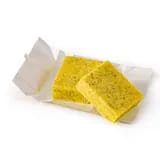Ingredients
Utensils
Stovetop, Kettle, Frying pan
recipe

Step 1
Boil 25 cl of water per person and dissolve the stock cubes.

Step 2
Remove the ends of the leeks*, keeping only the white parts. Chop finely. Place in a colander, rinse well to remove any dirt. *Check out our tips for this step

Step 3
Add the strained leeks to a dry frying pan (no oil) and cook on a high heat for 2 minutes, stirring. Add a ladle of stock and cook for 2 more minutes.


Step 4
Add the rice. Add a ladle of stock & the white wine (optional). Leave it to absorb, adding another ladle of stock.
Step 5
Continue until there's no more stock left. After 18-20 minutes, the rice should be cooked.


Step 6
If after 20 minutes the rice isn't cooked, add a bit more water and continue to cook. When it's cooked, add the parmesan, butter (optional: add a bit of cream), salt, pepper and mix well.
Step 7
Serve on plates, season, and serve!
For a zero-waste dish, use the discarded leek stalks to make soup ! Rinse well & remove all damaged, dry & yellow parts before adding to your pot with the ingredients of your choosing.
Un client astucieux
Personal notes
Add your own flavor!
Nutrition facts
Average estimated amount for one serving
| Energy | 403 cal. |
| Fat | 12 g |
| Carbohydrates | 62 g |
| Protein | 10 g |
| Fiber | 4 g |
Values are based on an average estimate for one serving. All nutrition information presented on Jow is intended for informational purposes only. If you have any concerns or questions about your health, please consult with a health-care professional.
On average, one serving of the recipe "Leek risotto" contains 403 Energy, 12 g of Fat, 62 g of Carbohydrates, 10 g of Protein, 4 g of Fiber.
Price per portion
| € | Nos recettes à -2 € par portion |
| €€ | Nos recettes entre 2 € et 4 € par portion |
| €€€ | Nos recettes à +4 € par portion |
Please note, the price above is dependent on your grocer and the available products in the grocery store you chose.
Scores


C Nutri-score
The Nutri-score is an indicator intended for understanding nutritional information. Recipes or products are classified from A to E according to their food composition to promote (fiber, proteins, fruits, vegetables, legumes, etc.) and foods to limit (energy, saturated fatty acids, sugars, salt, etc.).
A+ Green-score
The Green-score is an indicator representing the environmental impact of food products. The recipes or products are classified from A+ to F. It takes into account several factors on the pollution of air, water, oceans, soil, as well as the impacts on the biosphere. These impacts are studied throughout the product life cycle.
Retrieving reviews...



